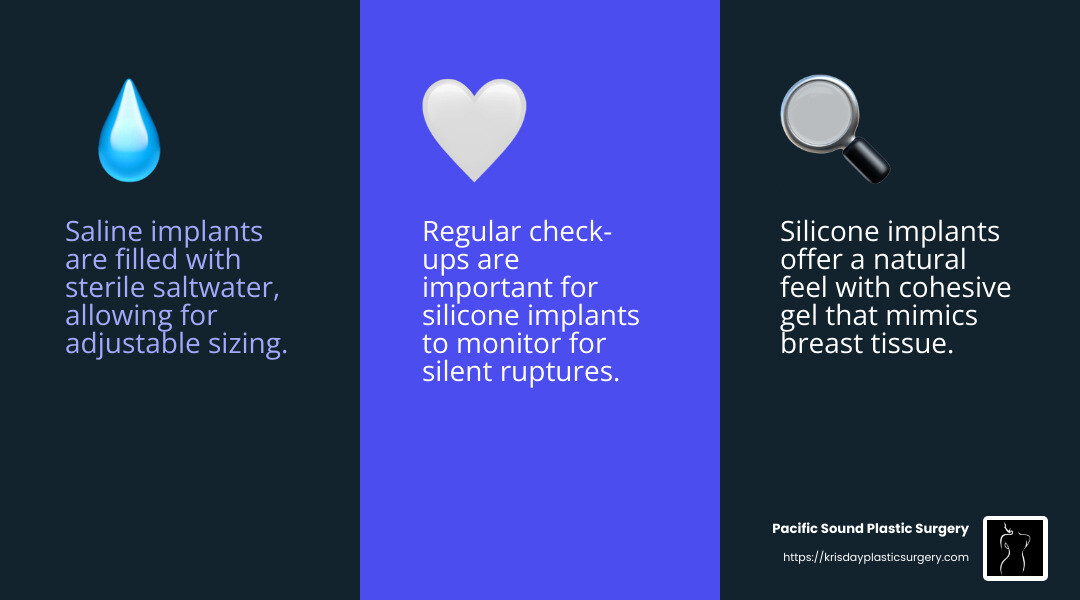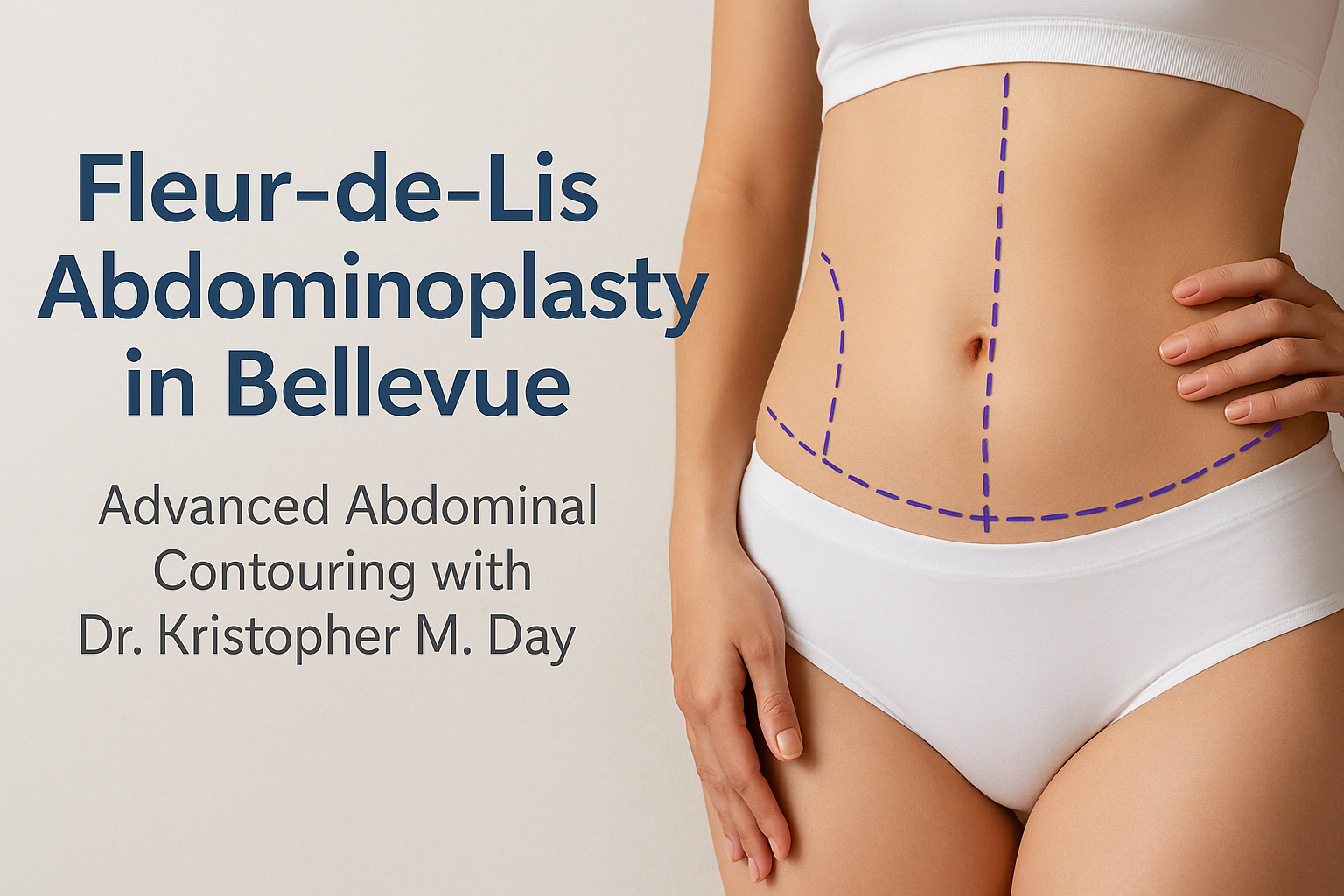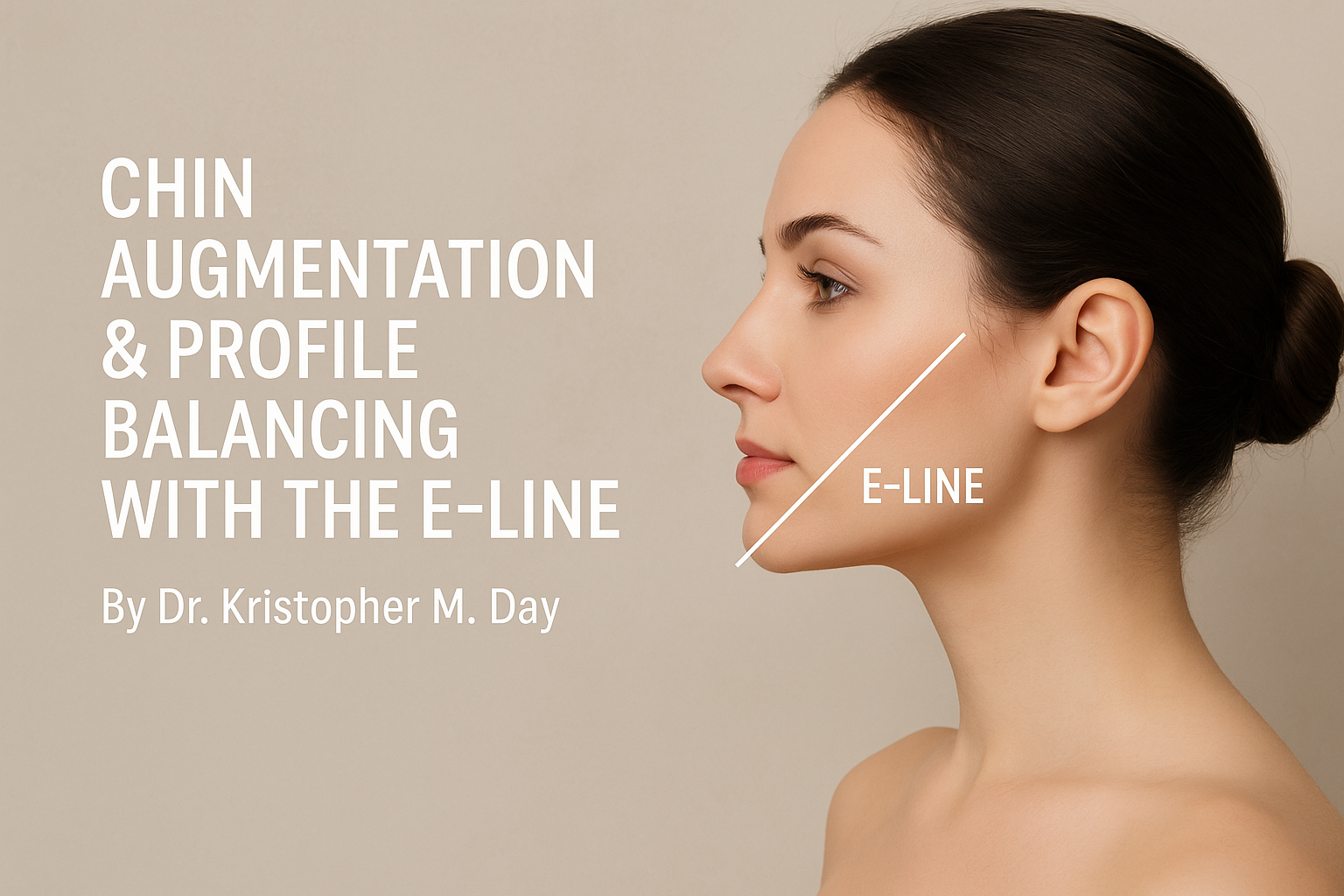
Types of breast implants are at the heart of breast augmentation, one of the most popular cosmetic procedures. For those seeking to improve body contours and boost self-confidence, understanding the varieties of implants is crucial. Here’s a quick overview of the options available:
- Saline Implants: Filled with sterile salt water; they offer a firmer feel.
- Silicone Implants: Filled with silicone gel, mimicking natural breast tissue.
- Cohesive Gel (“Gummy Bear”) Implants: Retain shape even if the shell is damaged.
- Round vs. Shaped Implants: Round implants provide uniform fullness, while shaped implants offer a natural slope.
- Textured vs. Smooth Implants: Textured implants adhere to tissue, and smooth implants allow natural movement.
Whether you desire subtle changes or more dramatic improvements, selecting the right type is key to achieving your desired outcome.
I’m Dr. Kristopher M. Day, MD, FACS, with experience in various types of breast implants. At Pacific Sound Plastic Surgery, I guide patients through exploring their options to ensure they make informed choices. Let’s dive deeper into understanding the nuances and benefits of each type.
Handy types of breast implants terms:
Types of Breast Implants
When considering breast implants, understand the differences between saline and silicone options. Each type has unique characteristics that cater to different preferences and needs.
Saline Implants
Saline implants are filled with sterile saltwater. They are inserted empty and filled once in place, allowing for a customizable size. This feature is particularly beneficial for achieving symmetry between breasts.
- Adjustable Size: Surgeons can fine-tune the volume during surgery, making adjustments easier.
- Rupture Safety: In the event of a rupture, the saline is harmlessly absorbed by the body, and the implant visibly deflates. This immediate deflation alerts you to any issues, making it a safe choice.
- Cost-Effective: Typically, saline implants are more affordable than their silicone counterparts.
Despite their advantages, saline implants might feel less natural than silicone, especially in individuals with less breast tissue. They can also exhibit more rippling.
Silicone Implants
Silicone implants are filled with a cohesive gel that closely mimics the feel of natural breast tissue. This makes them a popular choice for those seeking a more natural look and feel.
- Natural Feel: The cohesive gel provides a realistic texture, making silicone implants the preferred choice for many patients.
- Durability: Modern silicone implants are designed to be long-lasting, maintaining their shape over time.
- Regular Check-Ups: Since silicone implants do not deflate upon rupture, regular check-ups are essential to monitor their condition. This proactive approach ensures any issues are caught early.
While silicone implants offer many benefits, they generally require a larger incision for placement and come at a higher cost compared to saline implants.

By understanding these key differences, you can make an informed decision about which type of implant aligns best with your goals and lifestyle.
Shapes of Breast Implants
Choosing the right shape for your breast implants is crucial for achieving the desired look and feel. The two main shapes available are round and shaped implants, each offering unique features to consider.
Round Implants
Round implants are the most commonly used in the United States, accounting for the majority of breast augmentations. They are symmetrical, meaning they provide equal fullness to the upper and lower parts of the breast. This shape is versatile, making it suitable for a wide range of aesthetic goals.
- Symmetrical Shape: Because they are the same all around, round implants maintain their appearance even if they shift slightly within the breast pocket.
- Upper Fullness: They are ideal for patients who desire a noticeable lift and fuller appearance in the upper breast region.
- Versatility: Round implants can be used to achieve anything from subtle improvements to more dramatic changes, depending on the size and projection chosen.
Round implants are less likely to rotate, which makes them a reliable choice for those looking for consistency in their results.
Shaped Implants
Also known as anatomical or teardrop implants, shaped implants are designed to mimic the natural slope of the breast. They are thicker at the bottom and tapered at the top, providing a more natural contour.
- Anatomical Design: This design offers a natural-looking slope, making shaped implants a great choice for those seeking a subtle and realistic improvement.
- Natural Slope: The teardrop shape is particularly beneficial for patients with minimal breast tissue, as it can create a more natural silhouette.
- Careful Placement: Due to their specific shape, shaped implants require precise placement by the surgeon. Any rotation after surgery can alter the appearance, so careful surgical technique is essential.
Shaped implants are often chosen by patients who want a natural, understated look. However, they come with the potential risk of rotation, which can affect the final appearance.
By understanding the differences between round and shaped implants, you can better decide which option aligns with your aesthetic goals and personal preferences.
Surface Textures of Breast Implants
When selecting breast implants, it’s not just about size and shape. The surface texture is another crucial factor that influences how the implant interacts with your body. Let’s explore the two main types: textured and smooth implants.
Textured Implants
Textured implants have a rough surface designed to adhere to surrounding tissue. This unique feature can offer several benefits:
-
Tissue Adherence: The textured surface helps the implant stay in place, reducing the likelihood of movement within the breast pocket. This can be particularly beneficial for shaped implants, ensuring they maintain their intended position and appearance.
-
Reduced Movement: By promoting tissue adherence, textured implants minimize the risk of rotation. This is especially important for anatomical or teardrop-shaped implants, where rotation could alter the breast’s appearance.
-
Capsular Contracture: Some studies suggest that textured implants might lower the risk of capsular contracture. This condition occurs when scar tissue forms around the implant, causing it to harden and potentially distort the breast shape. However, it’s important to note that findings on this benefit are mixed.
Despite these advantages, textured implants have been linked to a rare type of cancer known as breast implant-associated anaplastic large cell lymphoma (BIA-ALCL). The FDA has highlighted this risk, particularly with certain textured implants, leading to recalls by some manufacturers.
Smooth Implants
Smooth implants feature a slick outer shell that allows for more natural movement within the breast pocket. Here are some key points about smooth implants:
-
Natural Movement: The smooth surface enables the implant to move freely, mimicking the natural motion of breast tissue. This can lead to a more natural look and feel, especially during physical activities.
-
Ease of Insertion: Smooth implants are often easier for surgeons to insert due to their slick exterior, which can simplify the surgical procedure.
-
Breast Pocket: Since smooth implants move within the breast pocket, they can adjust more naturally as the body changes, providing a more dynamic and lifelike appearance.
While smooth implants offer these benefits, they may have a slightly higher risk of capsular contracture compared to their textured counterparts. However, they do not carry the same cancer risk associated with some textured implants.
Choosing between textured and smooth implants depends on your specific needs and goals. Both types have their pros and cons, so discussing your options with a qualified surgeon is essential to making the best decision for your body and lifestyle.
Comparing the Types of Implants
When considering breast implants, it’s important to weigh the pros and cons of each type. Here’s a quick breakdown to help you make an informed decision.
Advantages and Disadvantages
Saline Implants
-
Advantages:
- Cost-Effective: Generally less expensive than silicone implants.
- Rupture Recognition: If they leak, the saline is harmlessly absorbed by the body, and the implant deflates, making it easy to detect a rupture.
- Adjustable Size: Surgeons can adjust the volume during surgery for more precise sizing.
-
Disadvantages:
- Feel: May not feel as natural as silicone, particularly in patients with less breast tissue.
- Rippling: More prone to visible rippling or wrinkling, especially in thinner individuals.
Silicone Implants
-
Advantages:
- Natural Feel: Mimics the feel of natural breast tissue, making it a popular choice.
- Aesthetic Appeal: Less likely to ripple, providing a smoother appearance.
-
Disadvantages:
- Cost: Typically more expensive than saline implants.
- Rupture Detection: Leaks are less obvious, requiring regular check-ups to monitor for “silent ruptures.”
Safety and FDA Approvals
Both saline and silicone implants are FDA-approved, ensuring that they meet safety and efficacy standards. However, it’s crucial to stay informed about potential risks and the need for regular follow-ups.
-
Safety Considerations:
- Capsular Contracture: Both types can lead to this condition, where scar tissue hardens around the implant. Textured implants might reduce this risk, but results are mixed.
- Rupture Risks: While saline ruptures are immediately noticeable, silicone ruptures require imaging tests for detection.
-
FDA Guidelines:
- For silicone implants, the FDA recommends routine monitoring with ultrasound or MRI after 5 to 6 years, then every 2 to 3 years afterward, to ensure implant integrity.
Knowing the advantages and disadvantages of each implant type, along with their safety profiles, is vital for making an informed choice. Always discuss your options with a qualified surgeon to ensure the best outcome for your body and lifestyle.
The Consultation Process
Choosing the right breast implants starts with a thorough consultation at Pacific Sound Plastic Surgery. This step is crucial for aligning your desires with the best surgical options.
Goals Discussion
First, Dr. Kristopher M. Day will discuss your goals. Whether you’re looking to improve size, restore volume, or correct asymmetry, expressing your expectations is key. Dr. Day listens carefully to understand what you hope to achieve. This open dialogue ensures that the plan reflects your unique vision.
Physical Examination
Next, a physical examination helps in tailoring the procedure to your body type. Dr. Day evaluates your natural breast size, chest width, and skin quality. This assessment is vital for recommending the most suitable implant type and size. The goal is to achieve a harmonious and balanced look that complements your frame.
Visual Aids
To help visualize potential outcomes, Dr. Day may use visual aids like before-and-after photos or 3D imaging. These tools provide a realistic preview of what you can expect post-surgery. Seeing examples of different implant types and placements can clarify your choices and set realistic expectations.
During the consultation, any concerns or questions about the procedure, recovery, and implant options will be thoroughly addressed. This comprehensive approach ensures that you feel confident and informed every step of the way.
Factors to Consider Before Surgery
When you’re planning for breast augmentation, it’s important to think about several key factors. These considerations help ensure that the results align with your lifestyle and body type, while also setting realistic goals.
Lifestyle and Body Type
Lifestyle: Your daily activities play a big role in choosing the right breast implants. If you lead an active lifestyle, such as participating in sports or physical activities, you might prefer implants that offer more comfort and flexibility. For instance, smooth implants can provide more natural movement, which can be beneficial if you’re frequently on the move.
Body Type: Your natural body proportions are crucial when selecting implants. Consider your breast size, chest width, and overall body shape. These factors influence the type and size of implants that will best complement your frame. The goal is to achieve a balanced look that improves your natural contours.
Goals and Expectations
Clear Goals: It’s essential to have a clear vision of what you want to achieve with breast augmentation. Are you looking to increase volume, improve symmetry, or restore fullness lost due to weight changes or pregnancy? Defining your goals helps guide the decision-making process.
Realistic Expectations: While breast augmentation can significantly improve your appearance, it’s important to maintain realistic expectations. Understanding the limitations and potential outcomes of the surgery ensures satisfaction with the results. Dr. Kristopher M. Day will help you set achievable goals based on your unique anatomy and desired look.
By considering these factors, you can make informed decisions that align with your lifestyle and aesthetic preferences. This thoughtful approach ensures that your breast augmentation journey is both rewarding and fulfilling.
Frequently Asked Questions about Types of Breast Implants
Choosing the right breast implant is a significant decision. Here, we address some of the most common questions to help you make an informed choice.
What are the main types of breast implants?
There are three main types of breast implants: saline, silicone, and gummy bear implants.
-
Saline Implants: These are filled with sterile saltwater. They offer the advantage of adjustable size during surgery and are known for their safety. If a saline implant ruptures, the body harmlessly absorbs the saline solution, and the implant will deflate, making the rupture immediately noticeable.
-
Silicone Implants: Pre-filled with a cohesive silicone gel, these implants are often chosen for their natural look and feel. They maintain their shape and are less prone to rippling compared to saline implants. However, they require regular check-ups to monitor for silent ruptures, as they don’t deflate like saline implants.
-
Gummy Bear Implants: These are a type of cohesive silicone implant known for their form stability. The gel inside is thicker, maintaining its shape even if the outer shell is compromised. They are less likely to leak but tend to be firmer than traditional silicone implants.
Which type of breast implant is best for a natural look?
For a natural appearance, silicone implants are often the preferred choice. The cohesive gel inside these implants closely mimics the texture and feel of natural breast tissue.

Gummy bear implants also offer a natural look due to their anatomical design, which mimics the natural slope of the breast. These implants are particularly popular among those with minimal breast tissue, as they provide a more realistic contour.
What are the risks associated with breast implants?
While breast implants are generally safe, they come with potential risks:
-
Capsular Contracture: This occurs when the scar tissue around the implant hardens, potentially causing discomfort or altering the breast’s appearance. Textured implants may reduce this risk by promoting tissue adherence.
-
Rupture: Both saline and silicone implants can rupture, but the implications differ. Saline implants deflate and are immediately noticeable, while silicone implants require regular imaging (such as MRI or ultrasound) to detect silent ruptures.
-
BIA-ALCL (Breast Implant-Associated Anaplastic Large Cell Lymphoma): This is a rare form of cancer that has been linked to textured implants. It’s crucial to discuss this risk with your surgeon and understand how it might influence your choice of implant.
Understanding these risks allows you to make an informed decision and take proactive steps for your health and safety. Regular follow-ups with your surgeon are essential to monitor the condition of your implants over time.
Conclusion
At Pacific Sound Plastic Surgery, we understand that choosing the right breast implant is a deeply personal decision. Our goal is to provide you with personalized care and expert guidance throughout your journey. Our board-certified surgeons are dedicated to helping you achieve your aesthetic goals while prioritizing your safety and well-being.
We take pride in our boutique approach, which emphasizes individualized treatment plans custom to your unique needs and lifestyle. From the initial consultation to post-surgery follow-ups, we are committed to ensuring that you feel supported and informed every step of the way.
Whether you’re considering saline, silicone, or gummy bear implants, our team will work closely with you to understand your vision and provide recommendations that align with your body type and personal preferences. We believe that informed patients make the best decisions, and we are here to answer all your questions and address any concerns you may have.
If you’re ready to explore your options for breast augmentation and learn more about how we can help you achieve your desired results, contact us today to schedule your consultation with Dr. Kristopher M. Day. At Pacific Sound Plastic Surgery, we are committed to delivering exceptional outcomes and enhancing your natural beauty.



